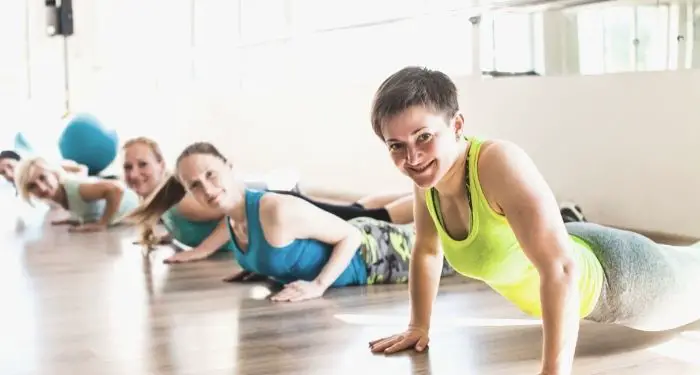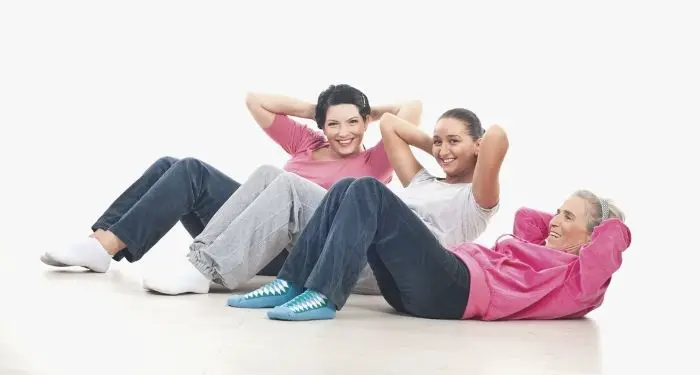Table of Contents
How do you stop the signs of aging? It’s a question that has plagued people for as long as any of us can remember, and contrary to popular belief, the answer is simpler than you think.
Strength Training Benefits For Older Women
The best-kept secret to anti-aging all boils down to exercise. Research has proven that a consistent routine of strength training for women over 50, 60 and 70 will not only keep you feeling good, but will physically slow down the aging process. And while there are a variety of contenders that are geared towards burning fat and helping you stay active, one major player in the race against aging is strength training. Lifting weights plays host to a whole world of benefits that can do wonders when dealing with menopause and muscle weakness. If you’ve never tried working with weights before, it is always the right time to start reaping the advantages of such a practice.
It’s important to note that lifting weights and building muscle is extremely fundamental to boosting both your health and physical performance. It’s a common misconception among women that exercising with weights will give them “manly” body proportions, but that’s simply not true. If anything, weight lifting will do a lot in helping you shed fat to unveil long, lean muscle and will give you a shapelier figure. Gone are the days when women would focus solely on cardio as a means of keeping fit. As you get older, activities such as running that tends to put pressure on the knees will have more of an adverse effect.
Strength Training Benefits for Older Women
Before you dive into the specifics of strength training, it’s good to know what it can do for you.
While you should have definitely incorporated some of the moves into your routines when you were younger, this actually becomes more essential for women after they turn 50. Women will naturally lose 5 to 10 lbs of muscle per decade after 50, and because muscles are vital for burning calories even while at rest, less muscles means a lower chance of reducing fat.
In addition, lifting weights also builds bone density. When it comes to fitness, women over 60 benefit from strength training and flexibility. When you age, something as innocuous as a slight fall can have bad repercussions since your bones weaken over time, and strength training is one way to rectify this. It also lowers the risk of diabetes, stroke, and heart disease. When it comes to menopause, exercise is usually cited as the number one method of overcoming its uncomfortable symptoms. Using weights will tighten and tone the muscles and help you lose the fat that accompanies the hormone changes in your body. It can even tame the hot flashes, joint aches, and sleep problems that come with it.
Equipment Needed
Even doing strength training for around 20-30 minutes two to three times a week will make a noticeable difference in your lifestyle. And you certainly don’t need a gym membership or any expensive equipment to try. There are loads of moves that can done with only your body and a pair of free weights, or with the help of items you might find around the house, such as a desk chair or your dining table.
- Start off with free weights in different ranges, beginning with something as light as 2 lbs until you feel more comfortable lifting heavier ones. Remember, the best way to properly develop muscle is to do what seems right to you.
- An exercise mat can also be useful when doing core exercises and your cool down stretches—a must after every session to ensure that your muscles are being taken care of. Muscles tend to contract while lifting weights, and it’s crucial that you stretch them out afterwards because this is where you will see the results of your efforts.
- Dress comfortably in clothes that will keep you cool and relaxed, with stretchable fabric that will allow you to bend comfortably.
How to Get Started
Lifting weights is all about a gradual progression, especially if you’ve never attempted to do so. It’s better to begin with a low intensity and a light load and work your way up from there.
If you’re concerned about how well you’ll be able to handle actual weights, consider bodyweight exercises such as push-ups and squats to start, and then slowly incorporate dumbbells as you grow stronger and more familiar with the moves. Utilizing just your body weight is effective enough on its own in order to build muscle, but weights are great for expediting the process. Strength training tips:
- Focus on one movement, like a squat or a lunge, and finish several sets of 12-15 repetitions while first using no weights and then slowly building up the load you’re capable of carrying as you go through the sets.
- One important factor to keep in mind is that your form should always be correct before you decide to throw weights into the mix. Exercise is only as good as having the proper form, and doing the opposite will leave you with the risk of injury that will halt any progress you’ve already made.
- Next, while you might be tempted to focus solely on lifting weights to improve a specific section of your body, such as the arms or the stomach, true fat loss is achieved when there is muscle everywhere. This is why you should integrate a total body workout into your regimen.
- You can also opt to devote a specific exercise day to one body part, such as having an arms day, a legs day, and a core day.
- Make sure to include exercises that will target all muscle groups because ignoring one will only set you up for more problems in the future.
Moves to Try
1. Squats
This is a popular move because it’s the best way to maintain bone density in the lower body while also increasing bone health. Squats also target and strengthen the bones in the pelvis, which is where a majority of age-related incidents stem from.
2. Overhead press
An overhead press is done by sitting with your back straight on a chair and lifting the weights above your head. It’s crucial for increasing the muscle mass around your shoulders and decreasing the possibilities of the neck and lower back injuries that plague most women over 50.
3. Modified push-ups
Push-ups are an excellent means of activating the upper body, while the modified stance of resting your knees on the ground will make it easier for you to transition to a full push-up once you get the hang of it. You can even do standing push-ups against a wall or table edge if you find lying down too difficult.
4. Ab roll-ups
For core exercises, there’s nothing easier or more effective than rolling up to your bent knees and slowly rolling back down. This will bring the abdominal muscles towards your spine to make the muscles stronger and tighter.
While strength training for women over 50 is definitely the right way to go, it’s just as imperative that you listen to your body. Some soreness is to be expected after an exercise day, but you should not be experiencing any chronic pain in the weeks to come. If you’re working out following any pre-existing injuries, it might be best to seek advice from a trained professional if they think lifting weights will be beneficial to you. And though it’s normal to want to throw yourself into it headfirst, as you begin your journey, be sure to take rest days between sessions. Over exercising can be as detrimental to the health as not exercising at all, and it’s always better to find a happy medium as you get and stay in shape.
Winsome To Wisdom is a participant in the Amazon Services LLC Associates Program, an affiliate advertising program designed to provide a means for sites to earn advertising fees by advertising and linking to Amazon.com





